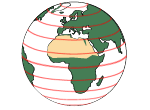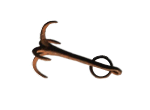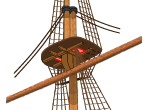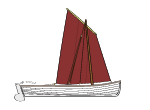
French-English glossary of nautical terms from the age of fighting sail 1780-1830
| A | B | C | D | E | F | G | H | I | J | K | L |
| M | N | O | P | Q | R | S | T | U | V | W | XYZ |
 |
 |
 |
 |
| V - French nautical vocabulary for readers of sea stories set in the period 1780-1830 | ||
| vague (nf) | wave | |
| vaisseau (nm). La définition dépend du contexte: (1) bâtiment, navire (2) grand navire de guerre |
vessel. The meaning depends on the context: (1) ship (2) large ship of war |
|
| vaisseau amiral | flagship | |
| vaisseau de guerre (par exemple la corvette, la frégate, le vaisseau de ligne - voir illustration. Voir aviso, bombarde, brick, canot, côtre, galère et tableau comparatif des bâtiments) | ship of war (warship, for example the sloop of war, frigate and ship of the line - see illustration. See advice boat, bomb-vessel, brig, boat, cutter, galley and vessel comparison chart) | |
| vaisseau de ligne (grand navire de guerre, propre à combattre en ligne de bataille, la formation de combat consistant à ranger les vaisseaux de haut rang les uns derrières les autres. Voir tableau comparatif des bâtiments) | ship of the line (large ship of war, capable of fighting in line of battle, the fighting formation in which ships carrying heavy guns proceeded one behind the other. See vessel comparison chart) | |
| vaisseau de premier rang (trois ponts, 70-120 canons. Voir tableau comparatif des bâtiments) | first rate (ship of the line with three gun-decks and 100-120 guns. See vessel comparison chart) | |
| valet à canon (nm, tampon de bourre; ce qu'on met par-dessus la charge des armes à feu pour la retenir) | wad (rammed into barrel of firearm after the charge, to keep it in place) | |
| vareuse (nf, courte blouse en toile à voile, blouse d'uniforme des matelots) | smock (short sailcloth jacket or smock, sailors' uniform jacket) | |
| vent (nm, voir aussi allures, alizés, contre-alizés et quarantièmes rugissants) | wind (see also points of sailing, trade winds, anti-trades and roaring forties) | |
| vent > à son vent | to windward of her | |
| vent > au vent | to windward, to weather | |
| vent > sous le vent | leeward, to leeward | |
| vent > vent de côté, vent de travers | wind on the beam (from the side) | |
| vent > vent de quartier | quartering wind, wind from the quarter | |
| vent > vent arrière | wind from astern | |
| vent > par vent arrière | with the wind astern | |
| vent > vent debout (un voilier est vent debout quand sa proue se trouve dans la direction d’où souffle le vent) | headwind, wind from ahead (a vessel is head to wind when its bow points in the direction from which the wind is blowing) | |
| vent > dans le lit du vent (face au vent, la position en drapeau) | upwind, head to wind (boat or ship pointing directly upwind) | |
| vent > vent contraire. «Le vent n'est pas favorable pour virer sur bâbord.» | foul wind. "The wind is foul for a tack to port." | |
| vent > avoir l'avantage du vent, être au lof de l'ennemi, avoir le vent sur l'ennemi | to have the weather gage, to be upwind of the enemy | |
| vent > gagner l'avantage du vent sur un vaisseau ennemi | to get the weather gage of an enemy ship, to get to windward of an enemy ship | |
| vent > vent reculant, retournant ou revenant (le vent revient ou recule lorsque sa direction varie selon le sens inverse des aiguilles d'une montre). Voir aussi vent virant | backing wind (the wind backs when it changes direction counter-clockwise). See also veering) | |
| vent > «Le vent avait reculé au sud.» | "The wind had backed southerly." | |
| vent > vent virant, tournant (le vent vire lorsque sa direction varie selon le sens des aiguilles d'une montre). Voir aussi vent > reculant | veering wind (the wind veers when it changes direction clockwise). See also backing | |
| vent > échelle de Beaufort (1805): | Beaufort scale (1805) : | |
| vent > Beaufort 0 - calme | Beaufort 0 - calm | |
| vent > Beaufort 1 - très légère brise | Beaufort 1 - light air | |
| vent > Beaufort 2 - légère brise | Beaufort 2 - light breeze | |
| vent > Beaufort 3 - petite brise | Beaufort 3 - gentle breeze | |
| vent > Beaufort 4 - jolie brise | Beaufort 4 - moderate breeze | |
| vent > Beaufort 5 - bonne brise | Beaufort 5 - fresh breeze | |
| vent > Beaufort 6 - vent frais | Beaufort 6 - strong breeze | |
| vent > Beaufort 7 - grand frais | Beaufort 7 - near gale | |
| vent > Beaufort 8 - coup de vent | Beaufort 8 - fresh gale | |
| vent > Beaufort 9 - fort coup de vent | Beaufort 9 - strong gale | |
| vent > Beaufort 10 - tempête | Beaufort 10 - storm, whole gale | |
| vent > Beaufort 11 - violente tempête | Beaufort 11 - violent storm | |
| vent > Beaufort 12 - ouragan | Beaufort 12 - hurricane | |
| vent > accalmie (nf) | lull | |
| vent > bouffée de vent | puff of wind | |
| vent > bourrasque (nf, coup de vent impétueux et de peu de durée, ou risée) | flaw (sudden brief increase in wind speed, or squall) | |
| vent > brise (nf) | breeze | |
| vent > brise de terre (vent de convection qui souffle de la terre à la mer pendant la nuit quand la température de l'eau dépasse celle de la terre avoisinante) | land breeze (night-time wind powered by convection currents which arise when the temperature of the sea is higher than that of the adjoining land) | |
| vent > brise de mer (vent de convection qui souffle de la mer à la terre pendant le jour quand la température de la terre dépasse celle de l'eau) | sea breeze (daytime wind powered by convection currents which arise when the temperature of the land is higher than that of the sea) | |
| vent > grain, rafale (renforcement brutal mais brève du vent, avec un net changement de direction (45 à 90°), et qui ne dure que quelques minutes. Une rafale peut atteindre une vitesse supérieure de 50 % à celle du vent moyen) | squall (sudden severe increase in wind strength, with a marked change in direction of 45 to 90°, lasting only a few minutes. Wind speeds may be more than 50% that either side of the squall) | |
| vent > risée (nf, augmentation soudaine mais brève de la vitesse du vent; moins violente et plus durable que la rafale) | flaw (sudden but temporary increase in wind speed; less violent and longer-lasting than a squall) | |
| vergue (nf, espar cylindrique, effilé à ses extrémités, placé en travers du mât, servant à soutenir et orienter la voile qui y est fixée. Les vergues sont fixées en leur milieu de façon à ce que l’on puisse en ajuster la hauteur. Elles sont le point de départ et d’arrivée de nombreux cordages qui servent à la manœuvre) | yard (cylindrical spar, tapering at the ends, which is placed horizontally with its centre against a mast and used to support the sail which is fixed to it. It is also used to alter the angle the sail makes with the wind. The yards are fixed in the middle in such a way that they can be raised and lowered. Much of the running rigging runs to and from the yards) | |
| vergue > la grand'vergue | the main yard | |
| vergue du grand hunier | main topsail yard | |
| vergue du grand perroquet | main topgallant yard | |
| vergue du grand cacatois | main royal yard | |
| vergues croisées, avoir les (être prêt à faire voile) | to have the yards across (to be ready to make sail) | |
| vergues en croix, avoir les (être prêt à faire voile) | to have the yards across (to be ready to make sail) | |
| vergues sèches (à sec de toile, sans aucune voile déployée) | under bare spars, bare poles (with no sails deployed) | |
| vigie (nf, veilleur) | lookout | |
| virer (v) (1) tourner (guindeau ou cabestan) (2) reprendre un cordage au moyen d’un cabestan ou d'un guindeau. (Si l'on reprend un cordage à la main, on utilise le verbe embraquer) (3) changer d'amure. Voir virer de bord (4) changer de direction. Mot employé pour indiquer que le vent tourne dans le sens horaire(voir aussi vent > reculant) |
(1) to turn (a winch or capstan) (2) to haul in a rope using a winch of capstan. (The word embraquer is used for hauling in a rope by hand) (3) to change tack. See go about (4) to change direction. This word is used to indicate that the wind is changing direction clockwise; technically, veering (see also backing) |
|
| « Virez l'amarre! » | "Haul in!" | |
| virer de bord (v, changer d’amure, soit vent arrière, soit vent debout; manœuvre consistant à franchir le lit du vent, de manière à recevoir le vent du bord opposé à celui qui le recevait précédemment. Un voilier est à bâbord amures s’il reçoit le vent de bâbord, c’est-à-dire de son côté gauche en regardant vers l'avant. Tribord amure, c’est l’envers) | to go about (to change tack, by putting either the stern or bow through the wind; a manoeuvre in which a ship is made to point directly upwind or downwind so that it can proceed with the wind coming from the other side. A sailing vessel is on the port tack when it receives the wind from the port side, which is the vessel’s left side when looking forwards. The starboard tack is the opposite) | |
| virer de bord > virer lof pour lof (v, virer de bord vent arrière; changer de route au point où le navire reçoit le vent de l'autre côté, en passant par l'allure de vent arrière) | to wear ship (to go about with the wind from behind; to change course to such an extent that the wind is on the other side of the ship, in such a way that halfway through the manoeuvre, the ship faces directly downwind) | |
| virer de bord > virer vent arrière - voir virer de bord > virer lof pour lof | to wear - see go about (tack or wear) | |
| virer de bord > virer vent debout (v). Virer vent devant; changer de route au point où le navire reçoit le vent de l'autre côté, en passant par le lit du vent (vent de face) | to tack (to turn the ship's head into the wind until it can proceed on the other tack, in other words its sails fill from the other side). See also go about (tack or wear) | |
| virer de bord > manquer à virer (résultat d'un virement de bord raté; le navire se retrouve dans le lit du vent, immobilisé ou dérivant, sans parvenir à repartir sur la nouvelle amure). Voir aussi bloqué dans le lit du vent | to miss stays (when attempting to tack; the ship is now head to wind, stationary or drifting, without being able to pay off on the new tack). See also in irons | |
| virer de bord > « Pare à virer!» (commandement pour disposer les hommes de quart aux manœuvres à l'instant où on veut faire virer de bord) | "Ready about!" (order to send the men on watch to the ropes when the ship is to tack or wear) | |
| virer de bord > vent devant > « Change derrière! » (ou « Décharge derrière! ») | “Mainsail haul! “ | |
| virer de bord > vent devant > « Change devant! » (ou « Décharge devant! ») | “Let go and haul!” | |
| virure (nf, une suite des planches longitudinales formant une partie du revêtement des membrures de la coque dans le sens de la longueur du navire) | strake (a set of planks joined end to end, running from one end of the ship to the other and forming part of the ship's hull planking) | |
| vit de mulet (nm, ferrure articulée qui relie un espar à un mât) | gooseneck (metal joint which attaches a spar to a mast) | |
| vitesse sur l'eau (la vitesse de surface) | speed through the water | |
| vitesse sur le fond (la vitesse vraie) | speed over the ground | |
| vives eaux (nfpl, voir aussi marée) | spring tides - see also tide | |
| vivres (nmpl, l’avitaillement du bord) | provisions (ship's food supplies) | |
| voguer (v): (1) ramer (2) naviguer, aller à la voile |
(1) to row (2) to sail |
|
| voie d'eau (nf) | leak | |
| voile (nf) | sail | |
| voile > les focs (un grand voilier peut avoir quatre ou cinq focs dont le clin-foc, grand foc, faux foc, petit foc, trinquette / tourmentin): | headsails / fore stay sails / jibs (a large sailing ship can have four or five headsails including the flying jib, outer jib, inner jib, fore topmast staysail, etc): | |
| voile > foc (nm, voile d'étai triangulaire enverguée sur l'étai du mât situé le plus en avant) | jib (a triangular sail of which the leading edge is attached to the forestay of the foremast) | |
| voile > trinquette (nf, tourmentin; voile d'étai d'avant. Une voile triangulaire établie sur un bas-étai, derrière le foc) | fore stay-sail (a triangular sail, set on a stay between the jib and the fore-mast) | |
| voile > basses voiles (les voiles carrées inférieures): | courses (the lower square sails): | |
| voile > misaine (nf) | foresail | |
| voile > grande voile, grand'voile (nf) | mainsail | |
| voile > voile d'artimon | mizzen | |
| voile > huniers (nm, les vergues et les voiles du hunier sont situées au-dessus des basses voiles. On appelle perroquet de fougue le hunier d'artimon) : | topsails (the topsail yards and sails are above the courses) : | |
| voile > petit hunier | fore topsail | |
| voile > grand hunier | main topsail | |
| voile > perroquets (nm, les vergues et les voiles du perroquet sont situées au-dessus des huniers. On appelle perruche le perroquet d'artimon) : | topgallants (the topgallant yards and sails are above the topsails): | |
| voile > petit perroquet (mât de misaine) | fore topgallant (foremast) | |
| voile > grand perroquet (grand mât) | main topgallant (main mast) | |
| voile > perroquet de fougue | mizzen topsail | |
| voile > perruche (mât d’artimon) | mizzen topgallant (mizzen mast) | |
| voile > cacatois (nm, les vergues et les voiles du cacatois sont situées au-dessus des perroquets) : | royals (the royal yards and sails are above the topgallants) : | |
| voile > petit cacatois | fore royal | |
| voile > grand cacatois | main royal | |
| voile > cacatois de perruche | mizzen royal | |
| voile > et autres : | and others: | |
| voile > bonnette (nf, voile carrée supplémentaire, ajoutée en dehors d'une voile principale par l'intermédiaire d'un bout-hors) | studding sail (additional square sail, added outboard of the main sails by rigging a temporary boom) | |
| voile > brigantine (nf, voile aurique hissée sur le mât d'artimon des voiliers gréés carrés, et sur tous les mâts des goélettes) | spanker or driver (triangular fore-and-aft sail set on the mizzen mast of a square rigged ship, and on all masts of a schooner) | |
| voile > voile aurique (se dit d’une voile ayant quatre côtés et qui a pour caractéristique de recevoir le vent toujours par le même bord d'attaque) | any four-sided sail fore-and-aft sail, in other words a sail rigged so that the same side is always the leading edge | |
| voile > voile à bourcet - voir voile au tiers | lugsail - see lug sail | |
| voile > voile carrée (voile à quatre côtés, portée par une vergue tenue à angle droit sur le mât, et qui ne peut marcher qu'en recevant le vent sur sa face arrière. Ses deux côtés verticaux peuvent être indifféremment au vent ou sous le vent, selon le côté d'où souffle le vent) |
|
square sail (four-sided sail, which hangs from a yard held at right-angles to the mast, and which works only when the wind fills it from behind. Either one of its vertical sides can be to windward, depending on the direction from which the wind is blowing) |
| voile > voile à corne (voile aurique, gréée par son bord supérieur sur une vergue appelée la corne dont l'extrémité inférieure, appuyée au mât, pivote selon l'axe du mât) | gaff sail (four-sided fore-and-aft sail which hangs from a yard along the top edge, called the gaff, of which the lowest end is against the mast and pivots in the same plane as the mast) | |
| voile > voile d'étai (voile triangulaire qui a pour caractéristique de recevoir le vent toujours par le même bord d'attaque, qui est enverguée sur un étai) | stay-sail (three-sided fore-and-aft sail with its leading edge rigged on a stay so that the same side is always the leading edge) | |
| voile > voile latine (voile triangulaire qui a pour caractéristique de recevoir le vent toujours par le même bord d'attaque, qui est enverguée sur une vergue latine ou antenne) | lateen sail (three-sided fore-and-aft sail with its leading edge rigged on a lateen yard so that the same side is always the leading edge) | |
| voile > voile à livarde (voile aurique sans corne ni bôme mais établie par un espar en diagonale appelé la livarde ou le balestron. Une voile d'embarcation ou de péniche mais voir aussi civadière) | sprit sail (four-sided fore-and-aft sail. It has no spar along the top or bottom edge but does have a diagonal spar called the sprit. A rig for a boat or barge, but a ship may also have a sprit-sail, rigged on the bowsprit) | |
| voile > voile au tiers (voile aurique, gréée par son bord supérieur sur une longue vergue. Hissée par son point de drisse au tiers de la vergue) | lugsail (four-sided fore-and-aft sail which hangs from a yard along the top edge. It is hoisted by a halyard one-third of the way along the yard) | |
| voile > voilure de lougre - voir voile au tiers | lugsail, lug rig - see lugsail | |
| voile > élément > chute (nf): (1) d'une voile carrée, les côtés verticaux (2) d'une voile aurique ou triangulaire, le bord de fuite, le côté situé vers l'arrière |
|
leech: (1) of a square sail, the vertical sides (2) of a fore-and-aft sail, the trailing edge, the edge nearest the stern |
| voile > élément > guindant (nm, bord d'attaque d'une voile aurique ou triangulaire) | luff (leading edge of a fore-and-aft sail) | |
| voile > élément > bordure (nf, bord inférieur d'une voile aurique ou triangulaire) | foot (bottom edge of a sail) | |
| voile > élément > point d'amure (nm): (1) d'une voile carrée, le coin inférieur au vent (2) d'une voile aurique ou triangulaire, l'angle inférieur et situé vers l'avant |
|
tack: (1) of a square sail, the bottom corner of the sail to windward (2) of a fore-and-aft sail, the bottom forward corner |
| voile > élément > point de drisse (nm, angle supérieur d'une voile triangulaire) | head (upper corner of a triangular sail) | |
| voile > élément > point d'écoute (nm): (1) d'une voile carrée, le coin inférieur sous le vent (2) d'une voile aurique ou triangulaire, l'angle inférieur et situé vers l'arrière |
|
clew: (1) the lee clew of a square sail is the bottom corner to leeward (2) the clew of a fore-and-aft sail is the bottom aft corner |
| voile > coiffer les voiles - voir coiffer ou masquer | to back the sails - see aback | |
| voile > faire voile (v) | to set sail | |
| voile > faire de la voile (v) | to make sail | |
| voile > mettre les voiles sur le mât - voir coiffer ou masquer | to back the sails - see aback | |
| voile > toutes voiles dehors | under all sail, under full sail | |
| voile > une voile sur le mât | one sail aback | |
| voûte d'arcasse, voûte d'étambot (nf, partie arrière de la coque d'un navire qui surplombe le gouvernail) | stern counter (part of a ship's stern that extends aft above the rudder) | |
| W - French nautical vocabulary for readers of sea stories set in the period 1780-1830 | ||
| XYZ | ||
| xebec (nm, chebec, petit bâtiment marchand; trois mâts à pible, et des voiles latines. Voir tableau comparatif des bâtiments) | xebec (small merchant vessel with three one-piece masts carrying lateen sails. See vessel comparison chart) | |
| yole (nf): (1) embarcation légère, effilée et allongée, d'un faible tirant d'eau, propulsée généralement à l'aviron, qui arme quatre à dix avirons (2) barque de passeur; canot à rames, léger et allongé, prévu pour deux rameurs |
|
(1) gig (light, slim, long, shallow-draught boat, usually rowed, for between four and ten oarsmen) (2) wherry (waterman's boat; a long, lightweight rowing boat, arranged for two oarsmen) |
| youyou (nm, une annexe, une très petite embarcation) | dinghy (a skiff or tender, a very small boat) | |